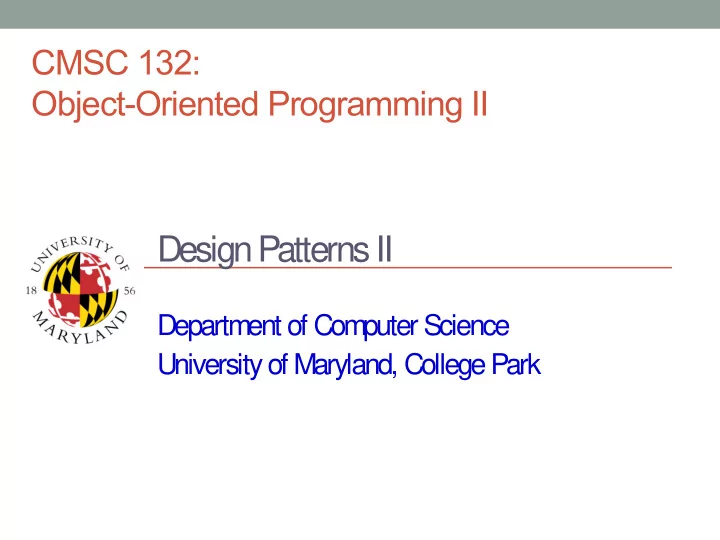

CMSC 132: Object-Oriented Programming II Design Patterns II Department of Computer Science University of Maryland, College Park
Observer Pattern • Definition – Updates all dependents of object automatically once object changes state • Where to use & benefits – One change affects one or many objects – Many object behavior depends on one object state – Need broadcast communication – Maintain consistency between objects – Observers do not need to constantly check for changes
Observer Pattern Window • Example Multiple windows (views) for single document – Window Original – Each window checks document ● Window updates image if document Window ● changes Think of window as asking “Are we there ● Window yet?” Using pattern – Each window registers as observer for ● document Doc Doc Document notifies all of its observers ● when it changes
Observer Example public interface Observer { public class MyWindow implements Observer { // called when observed object o changes public openDoc(Observable doc) { doc.addObservers(this); // add window to list public void update(Observable o, Object a) } } public void update(Observable doc, Object arg) { redraw(doc); // display updated document public class Observable { } protected void setChanged() } protected void clearChanged() public class MyDoc extends Observable { boolean hasChanged() public void edit() { … // edit document void addObserver(Observer o) setChanged(); // mark change void notifyObservers() notifyObservers(arg); // invokes update() void notifyObservers(Object a) } } }
State Pattern • Definition – Represent change in an object’s behavior using its member classes • Where to use & benefits Control states without many if-else statements – Represent states using classes – Every state has to act in a similar manner – Simplify and clarify the program – • Example States representing finite state machine (FSM) – Original – Each method chooses action depending on state ● Behavior may be confusing, state is implicit ● Using pattern – State interface defines list of actions for state ● Define inner classes implementing State interface ● Finite state machine instantiates each state and tracks its current state ● Current state used to choose action ● • Example: StateCode
State Example – Original Code public class FickleFruitVendor { boolean wearingHat; boolean isHatOn() { return wearingHat; } String requestFruit() { if (wearingHat) { wearingHat = false; return "Banana"; Apple } else { Not Wearing wearingHat = true; Wearing Hat Hat return "Apple"; Banana } } }
State Example public class WearingHat implements State { public interface State { boolean isHatOn(); boolean isHatOn() { return true; } String requestFruit(); String requestFruit() { // change state } currentState = notWearingHat; return "Banana"; public class FickleFruitVendor { } State wearingHat = new WearingHat(); } State notWearingHat = new NotWearingHat(); public class NotWearingHat implements State { // explicitly track current state of Vendor boolean isHatOn() { return false; } State currentState = wearingHat; String requestFruit() { // change state // behavior of Vendor depends on current state currentState = wearingHat; public boolean isHatOn() { return "Apple"; return currentState.isHatOn(); } } } public String requestFruit() { } Apple return currentState.requestFruit(); Not } Wearing Wearing } Hat Hat Banana
Visitor Pattern • Definition Define operations on elements of data structures without changing their classes – • Where to use & benefits Add operations to classes with different interfaces – Can modify operations on data structure easily – – Encapsulate operations on elements of data structure – Decouples classes for data structure and algorithms • Example Print elements in collection of objects – Original – Iterator chooses action based on type of object ● Many if-else statements ● Using pattern – Visitor interface defines actions during visit ● Visitable interface allow objects to accept visit ● Action automatically selected by polymorphic functions through double dispatch ● • Example: VisitorCode
Visitor Example – Original Code public void messyPrintCollection(Collection c) { for (Object o : c) { if (o instanceof String) System.out.println(“{"+o.toString()+“}"); // add { } else if (o instanceof Float) System.out.println(o.toString()+"f"); // add f else System.out.println(o.toString()); } }
Visitor Example public interface Visitor { public class PrintVisitor implements Visitor { public void visit(VisitableString s); public void visitCollection(Collection c) { public void visit(VisitableFloat f); for (Object o : c) { } if (o instanceof Visitable) public interface Visitable{ ((Visitable) o).accept(this); public void accept(Visitor v); else } System.out.println(o.toString()); } public class VisitableString implements Visitable { } private String value; public void visit(VisitableString s) { public VisitableString(String s) { value = s; } System.out.println(“{"+s.toString( )+“}"); public String toString( ) { return value.toString( ); } } public void accept(Visitor v) { v.visit(this); } public void visit (VisitableFloat f) { } System.out.println(f.toString( )+"f"); } public class VisitableFloat implements Visitable { } private Float value; public VisitableFloat(Float f) { value = f; } public String toString( ) { return value.toString( ); } public void accept(Visitor v) { v.visit(this); } }
Recommend
More recommend